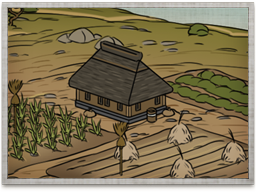Difference between revisions of "Rice Paddies (TWS2)"
(→Farm Yields with Equal Fields) |
m (→Farm Yields without Equal Fields) |
||
| Line 37: | Line 37: | ||
| 1500 | | 1500 | ||
| 1700 | | 1700 | ||
| − | | | + | | 1900 |
|- | |- | ||
| Average | | Average | ||
Revision as of 02:30, 8 November 2012
| Rice Paddies (TWS2) | |
|---|---|
 | |
| Chain | Farming Type |
| Requires | - |
| Enables | Buildings: |
| Spawned Defence Forces | - |
| Basic Building Statistics | |
| Clan Effects | - |
| See main article; FotS Buildings | |
Contents
Description
Order and chaos are only a chopstick's length apart.
Paddies are the artificially flooded fields where rice is grown. Rice is the staple foodstuff of all Japanese people, from the lowly peasant growing the crop to the mightiest daimyo enjoying his rice from an exquisitely elegant bowl. Taxes are measured in koku, or sacks of rice. Each province's basic wealth and therefore potential tax yield is measured by its rice output.
Working in rice paddies has always been long, exhausting work. The preparation of small dikes and channels to manage the water supply is a huge task for any farmer. Once the fields are properly laid out and flooded, the individual rice plants have to be hand-planted one at a time, a backbreaking task for anyone. The work was often communal, as most villages were self-governing and self-sustaining. A successful crop was not guaranteed, and a poor harvest would be doubly devastating as the peasants starved and their taxes to the local daimyo, often in taken rice, went unpaid. The violent repercussions of such disrespect and failure were rightly feared. Where the ruling clan was too weak or ineffective to impose taxes things were often no easier, as bandits would quite happily impose their own "taxes" on villagers. From the villagers's perspective, there was little to choose between taxmen and bandits. In this, at least, the Japanese peasants were identical to others all across the world.
Other Information
In the Campaign, every province has a Soil Quailty which determines the amount of wealth that is generated by farming. As such, any player that wants to strengthen their economy must take control of Provinces with rich soil and invest in upgrading their farms as soon as possible. Provinces with poor soil should only be upgraded if you have plenty of extra gold and need a surplus of food to sustain buildings that consume food.
Farm Yields without Equal Fields
| Rice Paddies | Improved Irrigation | Terrace Farming | Land Consolidation | |
|---|---|---|---|---|
| Very Fertile | 1800 | 2250 | 2550 | |
| Fertile | 1200 | 1500 | 1700 | 1900 |
| Average | 900 | 1125 | 1275 | |
| Meager | 780 | 974 | 1105 | |
| Barren | 600 | 750 | 850 |
Farm Yields with Equal Fields
| Rice Paddies | Improved Irrigation | Terrace Farming | Land Consolidation | |
|---|---|---|---|---|
| Very Fertile | 1836 | 2295 | 2601 | 2907 |
| Fertile | 1224 | 1530 | 1734 | 1938 |
| Average | 918 | 1147 | 1300 | 1453 |
| Meager | 795 | 994 | 1127 | 1259 |
| Barren | 612 | 765 | 867 | 969 |
Chosokabe Farm Yields without Equal Fields
| Rice Paddies | Improved Irrigation | Terrace Farming | Land Consolidation | |
|---|---|---|---|---|
| Very Fertile | 1980 | 2475 | 2805 | |
| Fertile | 1320 | 1650 | 1870 | |
| Average | 990 | 1237 | 1402 | |
| Meager | 857 | 1072 | 1215 | |
| Barren | 660 | 825 | 935 |
Chosokabe Farm Yields with Equal Fields
| Rice Paddies | Improved Irrigation | Terrace Farming | Land Consolidation | |
|---|---|---|---|---|
| Very Fertile | 2016 | 2520 | 2856 | 3192 |
| Fertile | 1344 | 1680 | 1904 | 2128 |
| Average | 1008 | 1260 | 1428 | 1596 |
| Meager | 873 | 1092 | 1237 | 1383 |
| Barren | 672 | 840 | 952 | 1064 |